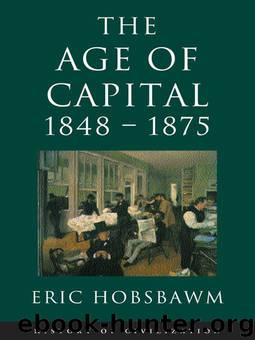Age of Capital 1848-1875 by Eric Hobsbawm

Author:Eric Hobsbawm [Hobsbawm, Eric]
Language: eng
Format: epub, mobi
Tags: non.fiction, history
ISBN: 9780297865285
Publisher: Hachette Littlehampton
Published: 2010-11-25T00:00:00+00:00
II
The economic forces moving agriculture in those areas where it was accessible to change were those of expansion. Yet over most of the world it inevitably came up against social and institutional obstacles which prevented or inhibited it, and in so doing also stood in the way of the other great task which capitalist – or indeed any – industrial development set its landed sector. For its function in the modern economy was not merely to supply food and raw material in rapidly growing quantities, but also to provide a – indeed the – most important reservoir of labour power for the non-agricultural occupations. Its third great function, that of providing the capital for urban and industrial development itself, it could hardly help fulfilling in agrarian countries, where there were few other sources of revenue for governments and the rich; though it might fulfil it inefficiently and inadequately.
The obstacles came from three sources: the peasants themselves, their social, political and economic superiors, and the entire weight of institutionalized traditional societies, of which pre-industrial agriculture was both the heart and the main body. All three were the predestined victims of capitalism, though, as we have seen, neither the peasantry nor the country-based social hierarchy which rested on its backs were in any immediate danger of collapse. At the very least, all three of these linked phenomena were theoretically incompatible with capitalism, and therefore tended to enter into collision with it.
For capitalism the land was a factor of production and a commodity peculiar only by its immobility and limited quantity, though, as it happens, the great opening of new lands at this period made these limitations appear relatively insignificant for the time being. The problem of what to do about those who happened to own this ‘natural monopoly’, thus levying a toll on the rest of the economy, therefore seemed relatively manageable. Agriculture was an ‘industry’ like any other, to be conducted on sound profit-maximizing principles, the farmer an entrepreneur. The rural world as a whole was a market, a source of labour, and a source of capital. In so far as its obstinate traditionalism prevented it from doing what political economy required, it had to be made to.
There was no possible way of reconciling such a view with that of peasants or landlords, for whom land was not merely a source of maximizable income but the framework of life; with that of social systems, for which the relations of men to the land and to each other in terms of the land were not, as it were, optional, but obligatory. Even at the level of government and political thinking, where the ‘laws of economics’ might be increasingly accepted, the conflict was stark. Traditional landlordism might be economically undesirable, but was it not the cement which held together a social structure which might otherwise collapse into anarchy and revolution? (The British land policy in India was to come to grief over this dilemma.) Economically it might be simpler if there was no
Download
This site does not store any files on its server. We only index and link to content provided by other sites. Please contact the content providers to delete copyright contents if any and email us, we'll remove relevant links or contents immediately.
International Integration of the Brazilian Economy by Elias C. Grivoyannis(90939)
The Radium Girls by Kate Moore(11921)
Turbulence by E. J. Noyes(7936)
Nudge - Improving Decisions about Health, Wealth, and Happiness by Thaler Sunstein(7615)
The Black Swan by Nassim Nicholas Taleb(7010)
Rich Dad Poor Dad by Robert T. Kiyosaki(6401)
Pioneering Portfolio Management by David F. Swensen(6226)
Man-made Catastrophes and Risk Information Concealment by Dmitry Chernov & Didier Sornette(5921)
Zero to One by Peter Thiel(5685)
Secrecy World by Jake Bernstein(4644)
Millionaire: The Philanderer, Gambler, and Duelist Who Invented Modern Finance by Janet Gleeson(4374)
The Age of Surveillance Capitalism by Shoshana Zuboff(4209)
Skin in the Game by Nassim Nicholas Taleb(4162)
Bullshit Jobs by David Graeber(4094)
The Money Culture by Michael Lewis(4076)
Skin in the Game: Hidden Asymmetries in Daily Life by Nassim Nicholas Taleb(3929)
The Dhandho Investor by Mohnish Pabrai(3699)
The Wisdom of Finance by Mihir Desai(3651)
Blockchain Basics by Daniel Drescher(3507)
